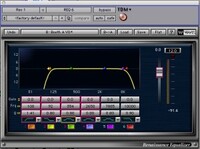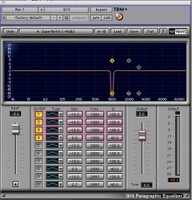 Here is a shelf curve that sort of looks like -- yes -- a shelf. Different EQ makers apply this differently and this one makes a slight cut prior to the boost. By the way these are pretty extreme boosts being made in these examples to more clearly show what is being discussed. Often EQ will be applied at much lower boosts or cuts and at several different frequencies. The idea with EQ is generally to do as little as possible to affect the desired change. You can easily mangle the recorded audio to something unacceptable.
Here is a shelf curve that sort of looks like -- yes -- a shelf. Different EQ makers apply this differently and this one makes a slight cut prior to the boost. By the way these are pretty extreme boosts being made in these examples to more clearly show what is being discussed. Often EQ will be applied at much lower boosts or cuts and at several different frequencies. The idea with EQ is generally to do as little as possible to affect the desired change. You can easily mangle the recorded audio to something unacceptable.
 This picture (right) shows a different type of EQ -- the curve at the left is called a "High Pass" filter and the curve at the right is called a "Low Pass" filter. These filters will remove all of the frequencies at the cut off frequency. So, in this example, the high pass filter removes all frequencies below 100 hertz and the low pass filter removes all frequencies above 10,000 hertz. These are very useful filters for removing unwanted elements of recordings.
This picture (right) shows a different type of EQ -- the curve at the left is called a "High Pass" filter and the curve at the right is called a "Low Pass" filter. These filters will remove all of the frequencies at the cut off frequency. So, in this example, the high pass filter removes all frequencies below 100 hertz and the low pass filter removes all frequencies above 10,000 hertz. These are very useful filters for removing unwanted elements of recordings.
These "pass filters" are powerful tools for affecting the recorded audio being processed. Here are a few examples that might shed light on their particular usage. Let's say that your boom man has trouble holding the pole and his fingers are creating small "boom" sounds during the recording. Often these noises are very low in the frequency range and are difficult to hear without a sub-woofer. A high pass filter may remove all of the noises without affecting the quality of the recording.
Or perhaps the tracks sound a bit "murky" so a slight presence boost at 2.5K or 3.5K may help "lift" the voice and a small cut at 300 -- 400 may remove a bit of "boominess." If you look at the EQ that has a low and high pass filter applied you'll see that it creates a "band" of frequencies that will pass through it. The other name for this sort of setting is a "band-pass" EQ and these can useful in a number of ways. Since band passes limit the frequency range of a recorded signal they are useful for many things. Many devices such a telephones have a "limited band-width" so you can mimic this bandwidth with a band pass filter.
 Let's say you hear a steady noise in your recording that is present in the upper frequencies. You may want to try a "notch filter" which can notch out the offending frequency. Here several bands are tied together to really define the notch. The idea here is to carve out only the offending frequency and try not to disturb anything else around it. As you can see a graphical EQ is a very handy way of visualizing your sound.
Let's say you hear a steady noise in your recording that is present in the upper frequencies. You may want to try a "notch filter" which can notch out the offending frequency. Here several bands are tied together to really define the notch. The idea here is to carve out only the offending frequency and try not to disturb anything else around it. As you can see a graphical EQ is a very handy way of visualizing your sound.
Mix engineers will often "sweep" the notch along that horizontal range of frequencies until the frequency range to reduce or add is pinpointed. Notches can be very useful in eliminating any type of steady state noise. Steady is the key idea because if the noise or sound oscillates to other frequencies then the notch is no longer relevant since it is specific to only a narrow range of frequency.
EQ is an amazing tool with many useful applications. However it is not a miracle device and it is most certainly not a noise reduction device. It can indeed reduce noise but it is less successful at that than a dedicated noise reduction device is.
There are "broad band" noises such as air conditioners that cross many frequencies at one time. They usually can not be notched or pass filtered out. They will require some different processing, but if you need simple boosts or cuts or if you have tones that need to be minimized or emphasized in your recordings that are steady state, EQ will be the right tool to use.
This is merely a quick explanation of this wonderful, misunderstood and useful tool. Experiment with EQ and learn how each of the controls affect the frequencies. Learn how cutting and boosting achieves different effects and how specific frequencies affect specific sources.
Listen to the world at large and imagine if you had to use EQ to recreate the sounds you hear. Walk by a stone building with music playing inside, loud but boomy and distant, what EQ curves might be applied to a standard music track to achieve a similar sound? Listen to the world around you. This in time will guide you on how to use EQ to mimic the sounds in and of everyday life. And then use those ideas to create the sounds you hear from this world -- or others. Comment with thoughts, ideas or questions at will.
This article was originally published at Woody's Sound Advice
